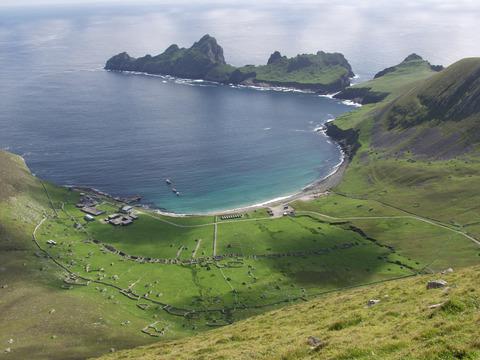Our official English website, www.x-mol.net, welcomes your
feedback! (Note: you will need to create a separate account there.)
The dynamics of vegetation grazed by a food-limited population of Soay sheep on St Kilda
Journal of Ecology ( IF 5.3 ) Pub Date : 2021-09-23 , DOI: 10.1111/1365-2745.13782 M.J. Crawley 1 , R.J. Pakeman 2 , S.D. Albon 2 , J.G. Pilkington 3 , I.R. Stevenson 3 , M.B. Morrissey 4 , O.R. Jones 5 , E. Allan 6 , A. Bento 7 , H. Hipperson 8 , G. Asefa 1 , J.M. Pemberton 3
中文翻译:

St Kilda 上受食物限制的 Soay 羊群放牧的植被动态
更新日期:2021-09-23
Journal of Ecology ( IF 5.3 ) Pub Date : 2021-09-23 , DOI: 10.1111/1365-2745.13782 M.J. Crawley 1 , R.J. Pakeman 2 , S.D. Albon 2 , J.G. Pilkington 3 , I.R. Stevenson 3 , M.B. Morrissey 4 , O.R. Jones 5 , E. Allan 6 , A. Bento 7 , H. Hipperson 8 , G. Asefa 1 , J.M. Pemberton 3
Affiliation

|
- The population of Soay sheep on the island of Hirta in the Outer Hebrides has been the subject of continuous study for more than 35 years. This paper focuses on the botanical aspects of the plant–herbivore interaction, showing how the vegetation affects and is affected by the sheep.
- Grazing impacts on biomass and spatial structure varied across plant communities, with Holcus/Agrostis grasslands affected most and Wet Heath least, consistent with the hypothesis that herbivore impacts are proportional to plant productivity.
- Within plant communities, the negative relationships between sheep numbers and plant abundance (sward height, gap/tussock cover and biomass) were significant in March but not significant in August, as expected if sheep numbers are limited by food supply in winter.
- In most species, flower stem density declined with increasing sheep numbers. There were no examples where unpalatable plants showed increased flowering (e.g. from competitor release under selective grazing).
- Plant production in temporary grazing exclosures (above-ground net primary production) was greatest in Holcus/Agrostis grassland (12.6 t ha−1 dry matter year−1), lower in Nardus grassland (5.1 t ha−1 year−1) and least in Plantago sward (1.3 t ha−1 year−1) associated with differences in historical nutrient supply and microclimate.
- The net effect of grazing on plant species richness was positive: A few highly palatable species were excluded, but small-scale coexistence of grazing-tolerant species was enhanced by defoliation.
- The Soay sheep population fluctuated from 908 (in 1988) to 2,208 (in 2009), increasing by an average of 39 extra animals per year over the period 1985–2011. Between 2011 and 2020, the population fluctuated less widely and showed no trend.
- Population change (ln(N(t + 1)/N(t))) was inversely density dependent but positively correlated with plant production in Holcus/Agrostis grassland which increased during the study.
- This plant–herbivore interaction is highly resilient, and though some species (Festuca rubra and Ranunculus acris) declined in the Holcus/Agrostis grassland, there was no significant upward trend in the abundance of unpalatable plant species.
- Synthesis. Implications for future studies and analyses of plant–herbivore data. Concentrating on estimating primary productivity and herbivore offtake, rather than simply measuring change in plant biomass, is likely to provide greatly improved explanatory power for understanding herbivore population dynamics.
中文翻译:

St Kilda 上受食物限制的 Soay 羊群放牧的植被动态
- 超过 35 年来,外赫布里底群岛 Hirta 岛上的 Soay 绵羊种群一直是持续研究的主题。本文侧重于植物与食草动物相互作用的植物学方面,展示了植被如何影响绵羊以及受绵羊的影响。
- 放牧对生物量和空间结构的影响因植物群落而异,Holcus / Agrostis草原受影响最大,湿荒地受影响最小,这与草食动物影响与植物生产力成正比的假设一致。
- 在植物群落内,绵羊数量与植物丰度(草地高度、间隙/草丛覆盖度和生物量)之间的负相关关系在 3 月份显着,但在 8 月份不显着,如果绵羊数量受到冬季食物供应的限制,则正如预期的那样。
- 在大多数物种中,花茎密度随着绵羊数量的增加而下降。没有令人讨厌的植物开花增加的例子(例如在选择性放牧下竞争者释放)。
- Holcus / Agrostis草原(12.6 t ha -1 干物质年-1)的临时放牧区(地上净初级生产)中的植物产量最高,Nardus草原较低(5.1 t ha -1 年-1),最低在车前草草场(1.3 t ha -1 年-1)与历史养分供应和小气候的差异有关。
- 放牧对植物物种丰富度的净效应是积极的:排除了一些非常可口的物种,但落叶增强了耐放牧物种的小规模共存。
- Soay 绵羊的数量从 908 头(1988 年)波动到 2,208 头(2009 年),在 1985 年至 2011 年期间平均每年增加 39 头。2011年至2020年间,人口波动幅度较小,无趋势。
- 种群变化 (ln( N ( t + 1)/ N ( t ))) 与密度成反比,但与Holcus / Agrostis草地的植物产量呈正相关,在研究期间增加。
- 这种植物与食草动物的相互作用具有很强的弹性,尽管Holcus / Agrostis草原的一些物种(Festuca rubra和Ranunculus acris)数量减少,但令人讨厌的植物物种的丰度没有显着上升趋势。
- 合成。对植物-食草动物数据未来研究和分析的影响。专注于估计初级生产力和食草动物摄入量,而不是简单地测量植物生物量的变化,可能会大大提高理解食草动物种群动态的解释力。











































 京公网安备 11010802027423号
京公网安备 11010802027423号